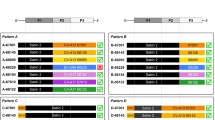Summary
The rct-marker test was performed on 129 and 33 virus isolates collected after oral vaccination with the live WM3 and Sabin type 3 vaccines, respectively. The main deviation of the WM3 isolates from the behavior of the original vaccine strain appeared during the first week after vaccination. The viruses isolated later showed few significant changes. Compared with the type 1 “CHAT” isolates investigated earlier the deviations from the pattern of the vaccine towards an improved replicative capacity at higher temperatures generally were more marked with the type 3 strain. The mean rct-ratios of WM3 and CHAT isolates tested at 35° C and 39.2°C, however, did not diverge markedly. The Sabin type 3 isolates did display at least a 10-fold higher growth capacity at 39.2°C compared with the WM3 and CHAT isolates. If less than a 2 log10 difference between replicative capacity at 38.9°C or 39.2°C and 35°C is chosen as a criterion for the rct + character then 8 isolates out of 90 tested from 5 of 30 WM3 vaccinees displayed the rct + character at 38.9°C. No isolate out of 39 tested deriving from 13 WM3 vaccinees had the rct + character at 39.2°C, and 2 isolates from 1 vaccine out of 33 isolates tested from 10 Sabin type 3 vaccinees had the rct + character at 39.2° C. The corresponding figures of the CHAT strain isolates were 2 crt + isolates out of 144 tested.
Similar content being viewed by others
References
Sabin, A. B.: Present position of immunization against poliomyelitis with live virus vaccines. Brit. med. J. March 14, 1959, p. 663.
Melnick, J. L., andM. Benyesh-Melnick: Problems associated with live polio-virus vaccine and its progeny after multiplication in man. Second Int. Conf. Live poliovirus vaccines. Pan Amer. San. Bur. Sci. Publ. No. 50, p. 12, 1960.
Verlinde, J. D., andJ. B. Wilterdink: Epidemiological and virological survey following oral administration of live poliovirus vaccine. Pan. Amer. San. Bur. Sci. Publ., p. 134 (1960).
Verlinde, J. D., andJ. B. Wilterdink: Relative stability of attenuated poliovirus (Sabin vaccine) after human passage as examined by rct/40 character and intracerebral monkey neurovirulence. VIIth. Symp. Europ. Ass. Poliomyelitis and Allied Diseases, p. 343, Oxford 1962.
Koprowski, H., R. Carp, T. W. Norton, B. Cohen, andS. Plotkin: The application of genetic markers to the development and control of live poliovirus vaccine. Live poliovirus vaccine. Second Int. Conf. Pan Amer. San. Bur. Sci. Publ. No. 50, p. 53, 1960.
Böttiger, Margareta, S. Gard, andR. Lagercrantz: Vaccination with attenuated type 1 poliovirus, the CHAT strain. I. A study in 20 families. Acta paediat. (Uppsala)55, 405 (1966).
Plotkin, S. A., T. W. Norton, B. J. Cohen, andH. Koprowski: A type 3 attenuated poliovirus genetically stable after human intestinal passage. Proc. Soc. exp. Biol. (N.Y.)107, 829 (1961).
Böttiger, Margareta: Studies on characteristics of poliovirus. III. Investigation of d, rct, n and h markers of poliovirus isolated after vaccination with type 1, CHAT strain. Arch. ges. Virusforsch.18, 135 (1966).
Böttiger, Margareta, andR. Lagercrantz: Immunization with inactivated poliovirus vaccine and attenuated type 3 poliovirus. I. Vaccination with the WM3 strain in 20 families. (To be published).
Böttiger, Margareta: Immunization with inactivated poliovirus vaccine and attenuated type 3 poliovirus. II. Parallel vaccination and crosswise revaccinations with the Sabin and WM3 attenuated poliovirus type 3 strains in school children. (To be published).
Böttiger, Margareta: Studies on characteristics of poliovirus. I. d marker and temperature. Arch. ges. Virusforsch.18, 119 (1966).
Magrath, D. I., L. R. Boulger, andE. G. Hartley: A reconsideration of the rct 40 marker test for differentiating strains of type 1 poliovirus. XIth. Symp. Europ. Ass. Poliomyelitis and Allied Dis. p. 304, 1968.
Benyesh-Melnick, M., andJ. L. Melnick: The use ofin vitro markers and monkey kidney neurovirulence tests to follow genetic changes in attenuated poliovirus multiplying in the human alimentary tract. First Int. Conf. Live Poliovirus Vaccines. Pan Amer. San. Bur. Sci. Publ. No. 44, p. 179, 1959.
Ghendon, I. Z., andA. T. Marchenko: Comparative investigation on the pathogenicity for monkeys and the ability to multiply at 40° C of different poliomyelitis virus. Acta virol.5, 91 (1961).
Author information
Authors and Affiliations
Rights and permissions
About this article
Cite this article
Böttiger, M. Rct-marker tests on isolates from WM 3 and Sabin type 3 attenuated poliovirus vaccinees. Archiv f Virusforschung 25, 299–307 (1968). https://doi.org/10.1007/BF01556558
Received:
Issue Date:
DOI: https://doi.org/10.1007/BF01556558




